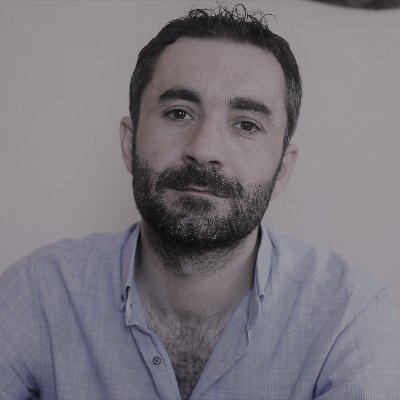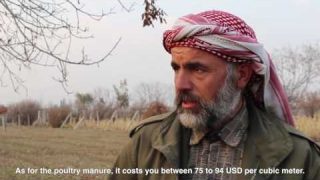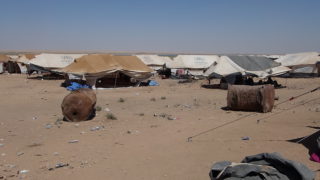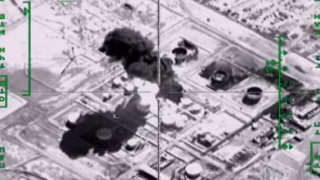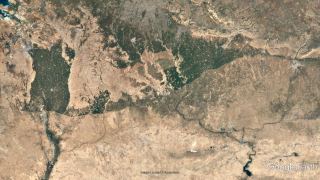This article was prepared in partnership and cooperation between Justice for Life and Syria Untold.
"We extract water from the ground and then put it back on the ground, so why should this be a problem? We've been using solar energy for three years and nothing has happened."
This is what Abu Jaber, a 54-years-old local farmer, from the eastern countryside of Deir Ezzor in northeastern Syria, says. In the past few years, an increasing number of farmers have replaced old diesel engines with solar panels as part of the so-called "sudden solar boom in Syria."
The shift comes after the war in Syria destroyed half of the country's infrastructure, including energy and irrigation infrastructure in rural areas. Syria's irrigated farmland has shrunk dramatically due to the destruction of water pumping stations and channels, electricity outages, and rising fuel prices. Moreover, severe and frequent droughts have rendered rain-fed agriculture useless in large parts of northeast Syria. These changes have led to the destruction of livelihoods, high rates of extreme poverty and displacement and have plunged the region into a severe humanitarian crisis.
Farmers in Deir Ezzor and other parts of northeast Syria have found that using solar energy for irrigation is the best solution to address the three conflict-related challenges besides the drought, where solar systems pump water without diesel and all other operational costs. This shift towards renewable energy is a market-driven transition that is made up of a large number of small investments carried out by rural households in northeast Syria.
Abu Jaber gives more details about these investments. "I sold my car and invested its price in buying the energy system, my neighbours borrowed $10,000 from their relatives abroad and pay off part of the debt every season, those who are doing better may invest from their savings, but in general they are small investments."
Challenges of the Solar Transition
Using solar power for irrigation does not seem to be a sustainable solution in given circumstances. There is a risk that cheap energy produced by solar panels will overpressure the region's fragile groundwater sources, especially if it is not associated with an effective water management policy and modernization of irrigation methods. A 38-year-old local farmer from the town of Ruwaished in rural Deir Ezzor said: "All that keeps us alive are these wells, but one-day Ruwaished will run out of water, some of us are sure of that, we just hope that day will not come quickly."
Northeast Syria is known as the most drought-valuable parts of the country and has been suffering from it for at least a decade before the war. Between 2007 and 2009, for example, "more than one million people were affected in the governorates of Hassakeh, Raqqa and Deir Ezzor, causing socio-economic instability, health problems, food insecurity and migration," according to ReportUnited Nations in 2010. In fact, there is a long list of Western studies linking climate change to the outbreak of conflict in Syria, until the Syrian war was classified as the world's first "Climate War".
There is a risk that cheap energy produced by solar panels will overpressure the region's fragile groundwater sources, especially if it is not associated with an effective water management policy and modernization of irrigation methods.
Within northeastern Syria we can differentiate between two main climatic and geographical zones: the agricultural area in the upper part including most of the governorates of Hasakah and Raqqa, where rainfall ranges from 200 to 600 mm per year and some surface water sources are available. The second region, where this article focuses on, is classified as a semi-arid region with rainfall of less than 200 mm per year including most of Deir Ezzor Governorate. Rain-fed farming there is useless and farmers are completely dependent on groundwater for irrigation. The following map shows the extensions of the two climatic zones:
Therefore, the excessive use of solar energy in groundwater extraction may have catastrophic consequences, especially since the use of solar energy makes groundwater extraction almost costless. Enabling farmers to grow more summer crops or expand irrigated land, which is already happening. Since the start of the Syrian war, the number of wells in Abu Khashab, for example, has risen from 280 in 2010 to 890 wells last year, according to Mohammed al-Hussein, head of the Deir Ezzor Farmers' Union, due to the fall of previously state-imposed restrictions.
Incomplete update
According to Hussein, approximately 55% of irrigated land in Deir Ezzor depends on groundwater. The traditional irrigation method is flood irrigation, which is inefficient and causes significant water waste. According to al-Hussein, the two areas of Abu Khashab and Ruwaished, located in the Deir Ezzor countryside, are among the pioneers in the transition to solar energy. Both areas are located away from surface water sources and have long relied on diesel engines to extract groundwater from private wells. At the same time, farmers face a major challenge to provide affordable diesel to operate these wells. The following map shows the location of the two areas targeted in this study Abu Khashab and Ruwaished.
So far, 30 to 40% of farmers in the Abu Khashab and Ruwaishid areas of eastern Deir Ezzor countryside have switched to solar energy, according to Asaad Alashmakh, 33-years-old, from rural Deir Ezzor, who works for a local NGO that supports agriculture in the area.
With the rapid growth in the capacity of solar energy systems against the low cost of purchasing them, the speed of extraction may outpace the speed of groundwater renewal. Describing this situation Alashmakh said: "Farmers see groundwater degradation when their wells don't provide the same amount or quality of water year after year. But most refuse to acknowledge that besides all the problems they face above ground, they still have more of them underground". The head of the Farmers Union (Al Hussein) also confirms this. "Previously, most wells operated in winter and stopped in summer. Wells used to take time to rest and replenish their water, now those who use solar energy are watering all seasons, and solar users often keep old diesel engines in place to cover the potential solar shortage in the winter and all these are unsustainable practices." The following satellite imagery shows a side of the Abu Khashab farms from 2024 summer where we can see that the only green farmland during this season is the one next to which solar panels are shown.
It is true that the transition to solar energy has become a global phenomenon, as much literature shows, and this comes within the framework of policies to limit global warming and climate change, but these transformations often come within legal, institutional and policy frameworks that manage and guide the energy transition, unlike the case in northern and eastern Syria, where public institutions are absent.
There is a long list of Western studies linking climate change to the outbreak of conflict in Syria, until the Syrian war was classified as the world's first "Climate War".
Farmers may seek greater economic benefits, even at the cost of threatening the sustainability of natural resources, but public authorities must intervene to protect those resources. In the case of northeast Syria, the governing authority of the Autonomous Administration of North and East Syria (AANES) is mainly focused on providing security and some basic services without effective development interventions. Abu Jaber told us that "the modernization of agriculture in our region is limited to replacing diesel with solar energy, and no investment is made in other aspects of agriculture such as the type of crops and irrigation methods because they are expensive and require expertise... Farmers can't do this alone."
Local agricultural authorities have minimal presence and interference in this area due to many issues, including a lack of political legitimacy, administrative capability, and lack of resources. "The Directorate of Agriculture is unable to lead the ongoing transformation, its support for farmers is limited and ineffective, and there are no annual agricultural plans," says Hussein, head of the Farmers' Union. “The directorate doesn't even have accurate numbers on solar-user farmlands.” This quote points to the institutional and policy vacancy that emerges here as a major barrier to maximizing the benefits of solar transition and mitigating its potential environmental impacts.
A Framework for Transformative Change!
In an ecologically fragile, war-affected region that lacks recognized public institutions such as in northeast Syria, a radical transformation of agricultural systems seems to be a pre-condition for ensuring sustainable living on the frontline with the expanding desert of the Badyat A’sham. "People feel the problem but they don't have a vision of how to deal with it, they are forced to continue farming in the current forms to feed their children and livestock, it is like a fall waiting for the moment of hitting the ground," says Asaad.
The excessive use of solar energy in groundwater extraction may have catastrophic consequences, especially since the use of solar energy makes groundwater extraction almost costless.
One of appropriate theoretical frameworks for our case might be the so called Conflict Transformation Approach, an approach that relies on an integrative approach to analyze and support sustainable agricultural transformation. It sees conflict as an opportunity to radically change existing agricultural systems. From this perspective, post-conflict agricultural recovery is not a process aimed at restoring the pre-conflict situation, but rather a transformative process aimed at sustainable agricultural systems. This encompasses all the physical, cognitive and social elements that make agriculture possible. The approach views farmers as key actors in a post-conflict context, contributing more to agricultural recovery than the state and the private sector, as has happened in several previous conflict countries.
Finally, in the absence of recognized public institutions, it is the responsibility of local and international NGOs already intervening in the region to bring together stakeholders to enable them to adopt a policy framework for the solar transition. The gap left by the absence or weakness of public institutions can be offset by a greater role for peasant associations and unions, who are the key stakeholders in transforming their current agricultural systems into more sustainable forms.


